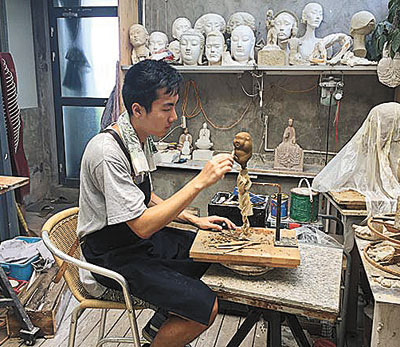
BUDDHA statues made by artist Jiang Sheng are not only displayed in galleries and museums, but also worshipped by Buddhists either in well-known temples or in their homes. The 26-year-old, among the youngest in China to devote himself to making Buddha statues, straddles art and craftsmanship to create his pieces. Statues made by Jiang are different from traditional images. The young man weaves “creative elements” into the gestures, positions and clothes based on the basic requirements of how a statue should look. For instance, the Buddha’s clothes are very long, like a waterfall pouring down. “The difference between me and a typical craftsman is creativity. Every time I produce a Buddha, I do research, read a lot and then put my own understanding into it,” says Jiang, who became a Buddhist in college six years ago. But when it comes to making statues for temples, he says they are different from his artworks or pieces for private collectors. For the temples, he has to “compromise” to make statues of the Buddha acceptable to the masses. Temples typically request him to make the Buddha’s head big to create a sense of divinity for the worshippers, something which Jiang does not do in his other artworks. Jiang’s mother became a devout Buddhist when he was a child. Influenced by his mother, he started reading the sutras in middle school. But it was only when he went to college that he turned fully to Buddhism and decided to create images of the Buddha. When he was a sophomore at the sculpture school of the Shanghai Institute of Visual Art, he once had to repair the hand of a statue at a temple in Suzhou, in East China’s Jiangsu Province. The days spent living in the temple and immersing himself in the world of Buddhism drew him more deeply to the faith. Since then, he has visited many grottoes housing Buddha statues and learned a lot from his teacher, who is an expert on the subject. After graduating in 2013, Jiang returned to his hometown Xiangmen in Fujian Province, also in the country’s east, where Buddhism has long been popular. There he set up a studio to make Buddha statues and quickly began receiving inquiries from temples, hotels and Buddhists. A Buddha statue can take him between six months and three years to complete. Usually, statues for temples are made in factories. But Jiang’s studio is different. “Every year, temple managers come to me and talk about an order. But only a few do a deal with me because many of them still can’t accept my statues. “It needs time to change the masses’ aesthetics of Buddha statues,” he says. Jiang says that the temples which accept his statues are always the newly built ones, such as a temple in Singapore and a temple featuring modern architecture in Shanghai. However, he also received an order from the South Putuo Temple in Xiamen, a famous Buddhist temple founded during the Tang Dynasty (618-907), to make a statue. He has been working on it for the past two years and has made many changes to his style in order to meet the requirements. So far, Jiang has produced more than 50 Buddha statues, many of them for Buddhists between 20 and 40, an age group that accepts his style of statues, which have elements of contemporary art. Besides making Buddha statues, Jiang also takes pictures of discarded religious sculptures. Since 2012, Jiang and two friends have been photographing thousands of statues that have been abandoned by their owners either because they are broken or because people have changed their beliefs. There are many temples or open spaces where these abandoned idols including Buddhas can be found. Many of these idols can also be seen in a cave in the South Putuo Temple. “I felt like these deities were migrating. They were made by craftsmen and owned by their worshipers. But then they were thrown away and maybe one day they will be picked up by another worshipper. It’s quite easy for people to change their beliefs these days,” says Jiang. From the thousands of photos he took, Jiang selected about 400 and put them into a book that he calls “Migrating Deities.” Though the book has yet to be published, some of the photos have already won him prizes. Inspired by the discarded idols, Jiang is now working on artworks that portray group images of different divinities. Jiang also loves traveling and fashion design. Last year, he worked with costume designers to put elements of Buddhist accessories into them. He describes himself both as an artist and a craftsman. And his cooperation with people in other fields has helped broaden his horizon and improve his Buddha statues. (China Daily) | 
